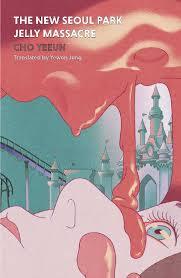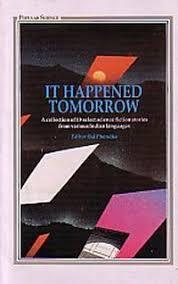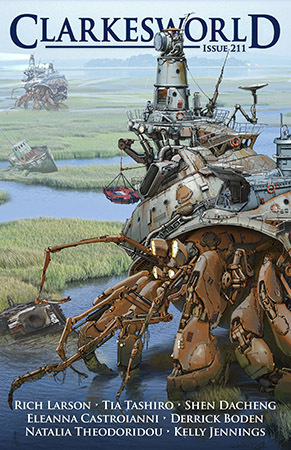Rachel S. Cordasco's Blog, page 6
May 5, 2024
Out This Month: May

“Renting to Killers” by Elena Pavlova, translated from the Bulgarian by the author and Kalin M. Nenov (Asimov’s, May/June)

Woodworm by Layla Martinez, translated from the Spanish (Spain) by Sophie Hughes and Annie McDermott (Two Lines Press, May 14)
The house breathes. The house contains bodies and secrets. The house is visited by ghosts, by angels that line the roof like insects, and by saints that burn the bedsheets with their haloes. It was built by a smalltime hustler as a means of controlling his wife, and even after so many years, their daughter and her granddaughter can’t leave. They may be witches or they may just be angry, but when the mysterious disappearance of a young boy draws unwanted attention, the two isolated women, already subjects of public scorn, combine forces with the spirits that haunt them in pursuit of something that resembles justice.
 The New Seoul Park Jelly Massacre by Cho Yeeun, translated from the Korean by Yewon Jung (Honford Star, May 16)
The New Seoul Park Jelly Massacre by Cho Yeeun, translated from the Korean by Yewon Jung (Honford Star, May 16)At New Seoul Park, Korea’s greatest theme park, an enigmatic man tempts visitors with a mysterious jelly candy that promises an unbreakable bond. As the sun beats down on a muggy summer afternoon, a child separated from her disinterested parents, a single mother striving to create a memorable day on a shoestring budget, and a couple on the brink of splitting up, all end up tasting this ominous candy. Little do they know that a sinister force lurks beneath the innocent facade. The sweet and innocent soon turns grotesque as the jelly becomes the catalyst for a sticky, sweet massacre. Masterfully translated by Yewon Jung, The New Seoul Park Jelly Massacre weaves a chilling tale of deceptive sweetness and the body horror of slowly melting into your loved ones.
 The Stronghold by Dino Buzzati, translated from the Italian by Lawrence Venuti (NYRB Classics, May 23) [new translation]
The Stronghold by Dino Buzzati, translated from the Italian by Lawrence Venuti (NYRB Classics, May 23) [new translation]Buzzati is one of the great Italian writers of the twentieth century, renowned for his fantastical imagination and for a touch that is as lyrical as it is light. The Stronghold, previously translated as The Tartar Steppe, is his most celebrated work, a book that has been read as a veiled attack on Mussolini’s fascist militarism, a prophetic allegory of the Cold War, and an existentialist fable.
May 3, 2024
Review: Wizard of the Crow by Ngũgĩ wa Thiong’o

translated by the author
original publication (from the Gikuyu): 2004
this edition: Pantheon, 2006
grab a copy here or through your local independent bookstore or library
“Sprawling” is the best way to describe Kenyan author Ngũgĩ wa Thiong’o’s Wizard of the Crow, a multi-layered, complex, and hilariously absurd magical realist book about the deeply corrupt Free Republic of Aburiria and the man who accidentally becomes the powerful Wizard of the Crow.
The Ruler of Aburiria, who often brags about how he killed thousands of communist during the Cold War and was praised by Western leaders, has now found himself in a post-Cold War world in which the rules of the game have changed. Global leaders don’t seem as interested in him and refuse to invite him to state functions or appear with him for tv interviews. After exiling his wife to a farm on the outskirts of the country for questioning his relationships with young girls (he feels that he has the right to sleep with anyone he wants, whether they’re young or old, married or not), he decides, with the help of his constantly-feuding ministers, to launch a project called Marching to Heaven. This will be a monument to the Ruler’s brilliance and generosity to his people, and the greatest wonder of the world, even though, as the people around him admit, the Tower of Babel didn’t go so well. The Ruler, though, is undeterred, and immediately applies to the Global Bank for funds to start construction.
After the Ruler travels to America to try to drum up support for his project, the story turns to a young man named Kamiti, who, despite his comprehensive education in India, has been unable to find a job in Eldares. He isn’t alone, though- his former fiancee and many other young people, with their degrees in business, finance, and administration, have been unable to find work in the major city of Aburiria. Thus they wander from temp job to temp job. Kamiti finds himself starving and homeless, lying on a trash heap, when he feels his soul leave his body. Determined not to die, he snaps back to life, scaring the three trash men who were about to hurl his body into the dump truck.
Kamiti then applies at a construction company for a temp job and is humiliated by its boss Tajirika, who only has contempt for Kamiti’s education and fluency in English. Tajirika’s secretary, Nyawira, is kind to Kamiti after he leaves and tries to make him feel better about his life, since she, too, had wandered for a while looking for work. A few days later, Kamiti and Nyawira both find themselves being chased by policemen at a dinner for the Global Bank representatives–Kamiti because he’s seen begging, and Nyawira because she’s with a protest movement pushing for freedom and free speech in the country. Nyawira brings Kamiti back to her house on the city’s outskirts to hide out until the police stop looking for them, but Kamiti has the idea of putting some materials associated with sorcery outside of the house. The policeman is terrified at the charms and runs off, after which Kamiti and Nyawira decide to continue the wizard act for a few more days.
Before they realize it, people have started showing up at their door, demanding to see the Wizard of the Crow (the name that Kamiti wrote on a sign at the door). Knowledgeable in the healing arts and the herbs that grow in the land around Eldares, Kamiti begins to advise his clients when they come to him with their medical problems. Even those, like the policeman who first chased them, who come with complaints about being passed over for promotions, are pleased with what the Wizard tells them. As Kamiti explains to Nyawira, just making someone see things from a different perspective is all that’s necessary to help them change their life. At other times, Kamiti does seem to have otherworldly powers; when he visits his parents after many years, his mother tells him that, actually, he is descended from a long line of seers and healers.
Meanwhile, Nyawira is busy organizing protests against the Ruler, including a dance, performed in front of the Global Bank visitors, in which a group of women demand that the Ruler release his wife. Embarrassed and angry, the Ruler decides to stand out the Movement for the Voice of the People. Nyawira’s ex-husband (John Kaniuru), seeking to move up in the government, tries to turn her in for her revolutionary work, but Nyawira escapes and hides with Kamiti.
The rest of the novel explores how the mythology of the Wizard of the Crow grows out of all proportion to its origins. Begun as a joke, it soon becomes the most important cultural phenomenon in the country, with regular people and government leaders all either wanting to consult with the Wizard or capture him to use him for their own means. Magical realist elements abound in the story, including a lake near Tajirika’s house where time stands still (the spell is only broken by tears of joy) and the Ruler’s “self-induced expansion” after he is humiliated by the Global Bank, which turns him down for funds for Marching to Heaven. While in New York, the Ruler suddenly starts expanding before everyone’s eyes, his anger at the Global Bank filling him up with hot air (?). After he returns to Aburiria, frustration over the fact that Nyawira and the Wizard of the Crow have disappeared makes him expand once more and fly up to the roof of his palace.
The constant feud between his top two ministers, and the rise of Tajirika and Kaniuru, expose the layers upon layers of corruption in the Ruler’s government, with embezzlement, backstabbing, lies, and forced confessions under torture the main features. Ngũgĩ offers us a clear, disturbing, and absurd picture of the state of the world in the early twenty-first century, with people like the Ruler trying to cut deals with Western governments, only to be told that now they must change their countries into democracies because the Cold War is over. The Ruler isn’t prepared to do that, but does tweak the system a little, though his overthrow is inevitable. The Wizard of the Crow and Nyawira, meanwhile, pursue their newfound purpose- changing their country’s culture one person at a time.
April 20, 2024
Review: You Glow in the Dark by Liliana Colanzi

translated by Chris Andrews
original publication (in Spanish): 2022
this edition: New Directions, 2024
grab a copy here or through your local independent bookstore or library
“Liliana Colanzi’s first collection in English, Our Dead World (2017), was so intriguing and strange that, when I found out about her second collection, You Glow in the Dark, I nearly jumped through the computer to get a copy. In that first book, Colanzi imagined, among other things, a cold, lonely colony on Mars; a meteorite potentially controlled by aliens; and a girl pushed into a nervous breakdown by her fanatical mother (à la Stephen King’s Carrie [1974]). You Glow in the Dark offers readers a similarly vibrant and diverse constellation of stories, but here Colanzi is also playing with time…”
Read my review on Strange Horizons.
April 16, 2024
Vladimir Colin at SF Ruminations

Here’s the second installment of my joint-SFT review with Joachim Boaz over at Science Fiction and Other Suspect Ruminations, this time on Vladimir Colin’s short story “The Contact” (1966, tr. 1970). Check it out here!
April 15, 2024
Review: The Book Censor’s Library by Bothayna Al-Essa

translated by Ranya Abdelrahman and Sawad Hussain
original publication (in Arabic): 2023
this edition: Restless Books, 2024
grab a copy here or through your local independent bookstore or library
“Reading a book about reading books is like entering a hall of mirrors: the experience is at once fascinating and disturbing. Like other stories about books and writing, The Book Censor’s Library drags the reader into itself, claiming to be one kind of book but unexpectedly (and imperceptibly) turning into another. Even the title throws the reader off guard. Why would a book censor have a library? ….”
Read my review on Necessary Fiction.
April 11, 2024
Review: Spinner of Darkness and Other Tales by Intan Paramaditha

trilingual edition: English, German, Indonesian
translated by Stephen J. Epstein (English), Pauline Kurbasik (German)
Lontar, 2015
grab a copy here or through your local independent bookstore or library
The four short stories in this lovely and haunting collection by Indonesian author Intan Paramaditha leave the reader feeling unmoored and unsure of what just happened. Each piece focuses on a woman trying to find her place in the world while attempting to understand the motivations and actions of the women and men around her. Paramaditha’s prose, in Epstein’s excellent translation, is smooth and unobtrusive, making it even more difficult for the reader to know where they are headed in each tale. Fairy tales and stories of modern life and woven together until it’s difficult to tell where one ends and the other begins.
“Spinner of Darkness” shifts back and forth between the protagonist’s childhood with her mother and her adult life, punctuated by a story her mother told her about an ugly old shapeshifting woman spinning a quilt in their attic (that’s why the attic is locked, according to her mother). The old woman’s attempt to find love with a human man by pretending to be young and beautiful, only for the man to see her as she truly is and run from fear, runs parallel to the protagonist’s own realization that she has never really known her mother. Divorced when the protagonist is young, her mother then sees a series of men, which leads to malicious gossip in their community. Only later, when the woman is supporting her mother, does the latter open the attic door, stand in front of an old mirror, and explain that she is the Spinner of Darkness.
If this story is tinged with the gothic horror of a twisted fairy tale, the next one, “Apple and Knife,” is simply disturbing. Once more, a woman (this time, Aunt Juli) who doesn’t conform to what her family and community expect from her, finds herself the subject of gossip and sneers. Organizing a “silaturahmi” (a gathering to strengthen ties), Juli introduces her younger lover to her female family members and friends, but only after she offers everyone an apple and very sharp knife. The sight of the young man causes the women to cut themselves while cutting their apples, and the blood mixing with apples makes the Snow White story seem quite tame in comparison. The women can’t seem to help themselves, though, perhaps driven by a strange combination of jealousy and masochism.
Blood and the color red suffuse “Snow Red,” in which a Palestinian refugee and a nomadic German woman set up a life together in an attempt to put down roots. Helga, though, is sometimes haunted by the memory of an old woman (Oma Rachel) she knew back in Germany–she loved her as a grandmother and listened to all of her fairy tales. One in particular stayed with her–the story of “Snow Red,” who takes people away when they’re longing for death. Only now, when Helga’s a grown woman, does she understand that the reason Oma Rachel and her family disappeared one day to go on a train ride was because they were being taken to Auschwitz. Eventually, Helga and Ismail’s uneventful life together is disturbed by what both start to suspect is “Snow Red,” since Ismail never truly moved past having to flee his home and Helga can’t move past her own regrets.
The final story, “A Single Firefly, a Thousand Rats,” is most like a fairy-tale, complete with a cemetery watchman and a mother and daughter who are both drawn to him. The sudden shift at the end of the story to New York and an overlay of the story onto modern city life is at once disturbing and striking.
Haunting in its darkness and carefully-controlled narrative voice, Spinner of Darkness is a compelling, beautiful example of contemporary Indonesian SF in translation.
April 10, 2024
Review: It Happened Tomorrow: A Collection of 19 Select Science Fiction Stories from Various Indian Languages

edited by Bal Phondke
various translators
National Book Trust, India, 1993
grab a copy here or through your local independent bookstore or library
translated stories:
“The Ice Age Cometh” by Jayant V. Narlikar, tr. from Marathi by the author
“The Impostor” by Bal Phondke, tr. from Marathi by the author
“Einstein the Second” by Laxman Londhe, tr. from Marathi by Arundhati Deosthale
“A Journey into Darkness” by Subodh Jawadekar, tr. from Marathi by Arundhati Deosthale
“The Man” by Niranjan S. Ghate, tr. from Marathi by Arundhati Deosthale
“Ruby” by Arun Mande, tr. from Marathi by Arundhati Deosthale
“Birthright” by Shubhada Gogate, tr. from Marathi by Arundhati Deosthale
“Catastrophe in Blue” by Anish Deb, tr. from Bengali by Manjushree Chaudhuri
“Time” by Sirshendu Mukhopadhyay, tr. from Bengali by Manjushree Chaudhuri
“The Elevation” by Niranjan Sinha, tr. from Bengali by Manjushree Chaudhuri
“Dilemma” by Sujatha, tr. from Tamil by Sakuntala Narasimhan
“Venus is Watching” by Rajashekar Bhoosnurmath, tr. from Kannada by the author
“The Lift” by Sanjay Havanur, tr. from Kannada by the author
“An Encounter with God” by Debabrata Dash, tr. from Oriya by the author
“Goodbye, Mr. Khanna” by Devendra Mewari, tr. from Hindi by Nishikant Mirajkar
“The Adopted Son” by Arvind Mishra, tr. from Hindi by Nishikant Mirajkar
With seven stories translated from Marathi, three from Bengali, two from Kannada, two from Hindi, one from Tamil, and one from Oriya, It Happened Tomorrow offers a fascinating window onto the landscape of science fiction written in Indian languages. I’ve added a map below to give you (and me!) a sense of where in India these languages are mostly spoken.

In his Preface to the anthology, Bal Phondke (who’s own story “The Imposter” is included) briefly discusses the evolution of “science fiction” in the West before turning to Indian science fiction, itself influenced by American and British writers. As time went by, of course, Indian science fiction authors started experimenting with stories that were more uniquely Indian, with themes, mythical references, and landscapes appropriate to the country. Bengali science fiction started being written at the end of the 19th century, while Marathi science fiction came into its own in the 1970s with the work of internationally-renowned astrophysicist Jayant Narlikar. Ultimately, Phondke argues, Indian science fiction needs to mix with the genre in other parts of the world in order to help it continue to develop–thus the existence of this current volume: “What is needed is cross-fertilisation of the Indian offerings with the fare the world at large has to offer. For that to occur, an introspective look at the entire spectrum of Indian science fiction would have to be resorted to, so that the strengths are recognized and the weaknesses identified. The present collection should act as a catalyst in promoting this much needed interaction” (xxii).
Most of the stories in this anthology are excellent, well-translated, and fascinating enough to draw the reader in and leave them wanting more. A perfect example of this is the very first story, written and translated by Jayant Narlikar himself- “The Ice Age Cometh” (presumably titled with a nod to Eugene O’Neill’s 1946 play). Set during a highly unusual blizzard in Bombay, Narlikar’s story follows a journalist (Rajiv) as he tries to understand how a scientist (Vasant) he once met predicted this catastrophe (which is affecting the entire world). According to that scientist, the decreasing temperature of the oceans is influencing a drop in atmospheric temperature, which is leading to a cycle of cooling that will bring about another ice age. Despite warning the world about this years before, Vasant was ignored because his results weren’t aligned with those of other scientists studying the climate. Once he’s taken seriously (and a large number of people have died), Vasant is allowed to launch a host of small metallic particles into the air, which will “absorb the sun’s heat and convey it to the earth down below.” This project is called “Invasion of Indra” because “Indra is the Lord of the Heavens whose abode is up above where all the trouble lies” (17). Though this is ultimately successful, the Earth and its population still must recover from the catastrophe’s consequences.
Three other stories take up similar themes relating to Earth ecology: “A Journey into Darkness,” “Catastrophe in Blue,” and “Venus is Watching.” In the first, darkness settles across the Earth because of the dust thrown into the air from bombs dropped during a war between America and the USSR. Ultimately, people start dying from radiation poisoning, suggesting an escalation to nuclear war. In “Catastrophe in Blue,” everything on the Earth takes on shades of that color, explained at the end in strictly scientific terms: “about thirty hours earlier, there was a massive explosion inside the sun. Scientists have not yet been able to find a plausible explanation for this phenomenon, but they have found that the explosion resulted in the production of a strange radioactive envelope around the sun. This radiation absorbed six out of the seven colours of the sun’s rays. Only the blue color was given a ‘gate-pass’ by them, because of which everything appeared blue” (139). Like “A Journey into Darkness,” “Venus is Watching” is concerned with nuclear war. This time, though, it is triggered by aliens living on a planet at the center of the Milky Way, using Venus to set off explosions on Earth in order to figure out how they can fight their enemies on a neighboring planet.
Other stories take up such themes as time travel (“Time,” “The Lift”), robotics and AI (“Ruby,” “The Man,” “The Elevation,” “Goodbye, Mr. Khanna,” “Dilemma”), and genetic and manipulation (“The Impostor,” “Birthright,” “The Adopted Son”). One story even features a brilliant scientist’s brain being removed against his will before he dies of cancer so that it can continue to work on the unified theory (“Einstein the Second”). Also, strangely, two different stories here feature robot secretaries named “Ruby” (“Ruby,” “Goodbye, Mr. Khanna”). Two others have scientists transferring memories via RNA between brains, prompting the recipients to think they are the person whose memories they now have (“The Impostor,” “The Adopted Son”). Only “Dilemma” is set on a spaceship, with a self-aware, increasingly-intelligent robot who may or may not be deliberately sabotaging the mission.
Ultimately, It Happened Tomorrow gives us a rare opportunity to read some fascinating science fiction from source languages we don’t usually encounter in translation in the West. I highly encourage you to grab a copy for yourself!
April 4, 2024
Review: Ice by Vladimir Sorokin

translated by Jamey Gambrell
original publication (in Russian): 2006
this edition: NYRB Classics, 2011
grab a copy here or through your local independent bookstore or library
So my first thought after finishing the 700 page Ice Trilogy was: “what the &^$&^% did I just read?”
My next thought was: “what did other reviewers think about it?” Here is a sample:
“Sorokin’s novel does exercise a monstrous fascination”- Christian Caryl, The New York Review of Books“The glib thing would be to declare Ice a spoof of Russia’s recent totalitarian past, or of totalitarianism or ideology or religion in general, but Sorokin’s ice cult hardly resonates with anything historical. Ice is much less a satire than a single monstrous vision: human beings are no more than “meat machines,” a race unable to communicate on a truly intimate scale and unworthy of continued existence.”- Ken Kalfus, The New York Times Book Review“What to make of the novel ? Is it pure allegory ? A political or religious statement ? A science fiction entertainment ? Who knows. Ice remains mystifying and often frustrating. Yet despite that, and despite the numbing repetitiveness of the ice-experiments, and despite the ridiculous premise there’s much that is compelling here.” – M. A. Orthofer, Complete ReviewBasically, Sorokin takes the Tunguska Event of 1908 (when a 3-5 megaton explosion flattened over 2,000 sq km of pine forest in Siberia- perhaps from a comet or asteroid) and imagines that it is actually special cosmic ice that will “awaken” 23,000 blond-haired, blue-eyed chosen people. Apparently, these people are actually Brothers of the Primordial Light, who created the various planets and celestial objects in the universe. When they decided to mess around one day and create a watery planet called Earth, they were reflected in the oceans and became trapped, evolving over eons to become humans. Their special souls, though, are reincarnated in every generation, thus preserving all 23,000 “brothers and sisters.” They have to find one another, hold hands in a circle, and “speak with the heart” in order to break free of the Earth, find their way back into space, and thus dissolve the Earth.
That’s the absurd premise. The way that Sorokin goes about developing it is actually masterful and head-spinning, if grotesque in places. As the various Brothers and Sisters explain over the course of the narrative, it is change that they despise, since the other planets they had created before Earth were perfect and dead. The narrative itself, interestingly enough, is filled with shifts and swerves, including multiple narrators, writing styles, and historical eras. The Brothers and Sisters infiltrate Lenin’s and Stalin’s governments, the Nazi high command, the millionaire class, and even start their own ICE corporation in the late 20th century to cover up their activities. These activities are…bizarre. In order to find one another, the chosen attach pieces of the Tunguska ice to poles and bash in the chests of other blue-eyed blonds. If they find a brother or sister, they hear a new name being “spoken” by the heart (these are all one or two syllable names). It worked well when two of the chosen were able to sense their compatriots, but when these two die, it’s up to the rest of the Brotherhood to figure out who’s one of them. Thus thousands of blue-eyed blonds around the world are kidnapped and bashed in with the ice, with most of these people dying from the blows and not “speaking with the heart.” The chosen call these people “empties.”
Some of the characters (especially the first main character, who’s “real” name is “Bro”) have extensive and interesting back stories, involving life before the Russian Revolution, before World War II, and during the Cold War. Ice is thus a sweeping historical narrative based on real events, but with a completely bizarre plot overlaid on them. The physiological and psychological changes that each chosen person goes through, however, makes it seem as though something real is happening to them, perhaps because of the ice or because of a mass hallucination.
Sorokin’s ability to drive the plot forward and bring the reader along for the wild ride is impressive. I found myself wanting these 23,000 delusional people to find each other, just so I could see what would happen at the end. And what an ending–of course it was strange, disappointing, and answered literally nothing. Nonetheless, Sorokin offers readers a strikingly unique look at totalitarian politics, delusion, and cultish institutions.
Also, I don’t know if this was part of the book or just a misprint, but about 50 pages were printed upside down. I tend to think this was deliberate, since the book is insane and also flipped around when a character fell to the ground and was looking up. This is kind of like when you go to a museum and see cans or something piled in the corner and you wonder if it’s supposed to be art or it’s just trash accidentally left there. If this book sounds like something you’d enjoy, go for it. But remember, it’s 700 pages of batsh*t craziness. Enjoy.
April 2, 2024
Out This Month: April
 “The Rambler” by Shen Dacheng, translated from the Chinese by Cara Healey (Clarkesworld, April 1)
“The Rambler” by Shen Dacheng, translated from the Chinese by Cara Healey (Clarkesworld, April 1) The Book Censor’s Library by Bothayna Al-Essa, translated from the Arabic by Ranya Abdelrahman and Sawad Hussain (Restless Books, April 30)
The Book Censor’s Library by Bothayna Al-Essa, translated from the Arabic by Ranya Abdelrahman and Sawad Hussain (Restless Books, April 30)A perilous and fantastical satire of banned books, secret libraries, and the looming eye of an all-powerful government.

Oracle by Thomas Olde Heuvelt, translated from the Dutch by ? (Tor Nightfire, April 30)
On a foggy winter morning Luca Wolf and Emma Reich discover an eighteenth-century sailing ship stranded on a barren flower field, its name written on its side: Oracle. Emma, unable to resist, enters the hatch on the tilted deck. The ship’s bell begins to toll and no one sees her again. Not much later, eleven people have disappeared, Luca and his mother have been absconded by a clandestine government agency which has questions, no answers, and are determined to uncover the ship’s secrets before a media storm erupts. But as they force Robert Grim, a retired specialist of the occult with a strange history and a healthy dislike of authority, to unravel the mystery, the Oracle is revealed to be a harbinger of an ancient doom awakened underneath the sea. What follows is a maelstrom of international intrigue, history, young love, humanity’s relationship with climate and disease, and pure terror as they come face to face with an open doorway to apocalypse.

Swan Knight by Fumio Takano, translated from the Japanese by Sharni Wilson (Luna Press Publishing, April 30)
As the nineteenth century draws toward its close, King Ludwig II of Bavaria binge-watches television to escape his reality, side-lined by his own advisers. His one wish is to meet Wagner, the mysterious composer pumping out new music and scores of remixes every day. He sets out, alone and in disguise, to find Wagner in the maze-like subterranean city that sprawls deep beneath Munich. Meanwhile, Karl, a rookie musician hired by Wagner in the underground world, is shocked to be chosen as the lead singer for the Swan Knight TV music drama. But even in the depths of the earth, the insidious shadow of political intrigue lurks. Who is Wagner, the man behind the myth? And what ultimate destiny awaits Ludwig and Karl?
March 23, 2024
Kōbō Abe at SF Ruminations

I joined Joachim Boaz over at Science Fiction and Other Suspect Ruminations for a double-review of Kōbō Abe’s 1950 (tr. 1989) short story “The Flood.” Check it out here!



